Comprehensive Financial Accounting Report for HNC Business Unit 10
VerifiedAdded on 2023/06/10
|33
|7917
|68
Report
AI Summary
This report provides a comprehensive overview of financial accounting principles and practices, focusing on Unit 10 of the HNC Business curriculum. It begins by defining financial accounting and explaining relevant regulations, accounting rules, and principles. The report then delves into the application of the double-entry bookkeeping system, demonstrating how to record sales and purchases in a general ledger and develop a trial balance. It also covers the preparation of final accounts for different business types, including sole traders, partnerships, and limited companies, considering adjustments for accruals, depreciation, and prepayments. Furthermore, the report explores bank reconciliation statements, detailing the process and importance of ensuring the validity of bank records, and concludes with a discussion on reconciling control accounts and clearing suspense accounts. The report includes practical applications and examples to illustrate key concepts and provides a thorough understanding of financial accounting practices.
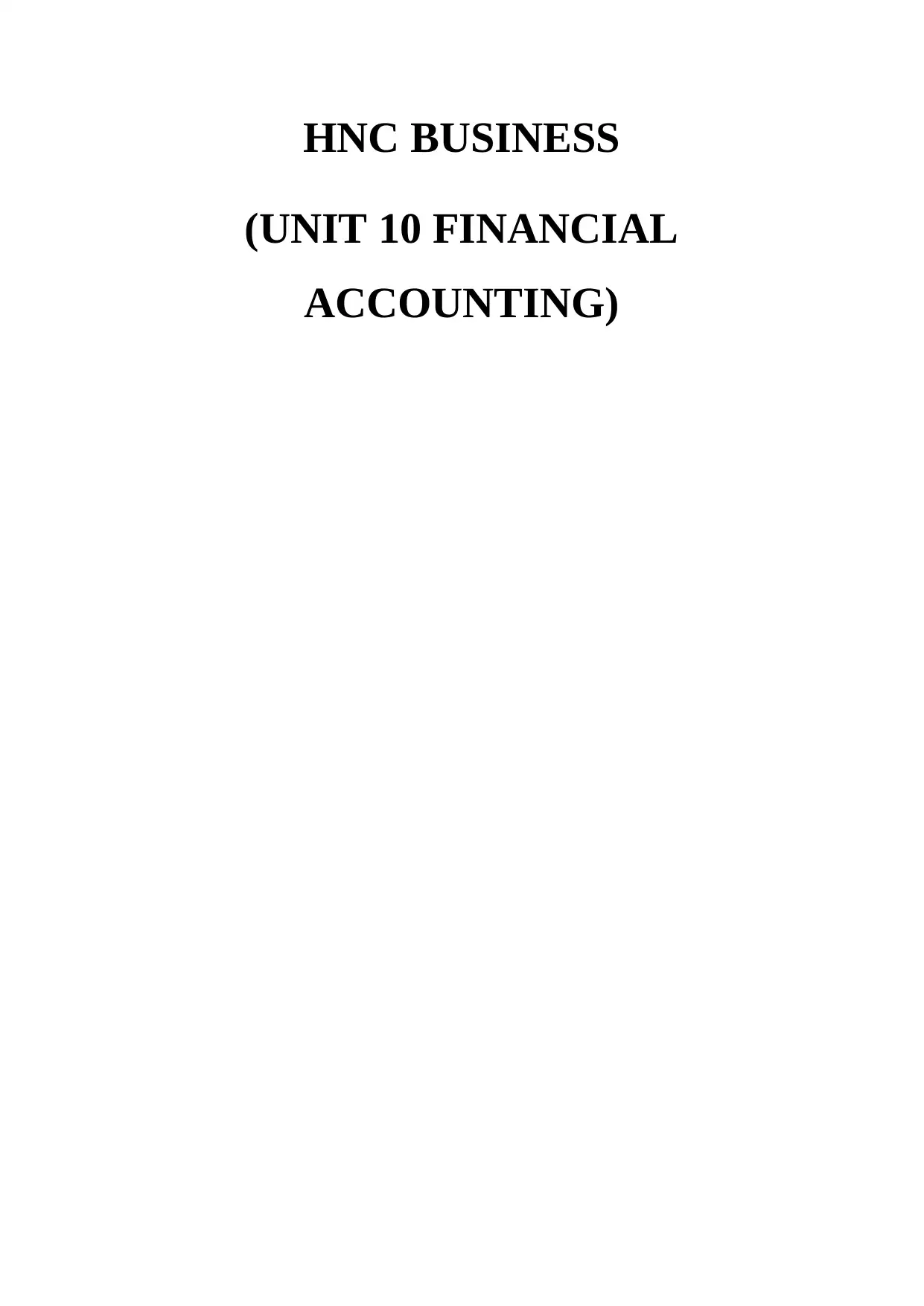
HNC BUSINESS
(UNIT 10 FINANCIAL
ACCOUNTING)
(UNIT 10 FINANCIAL
ACCOUNTING)
Paraphrase This Document
Need a fresh take? Get an instant paraphrase of this document with our AI Paraphraser
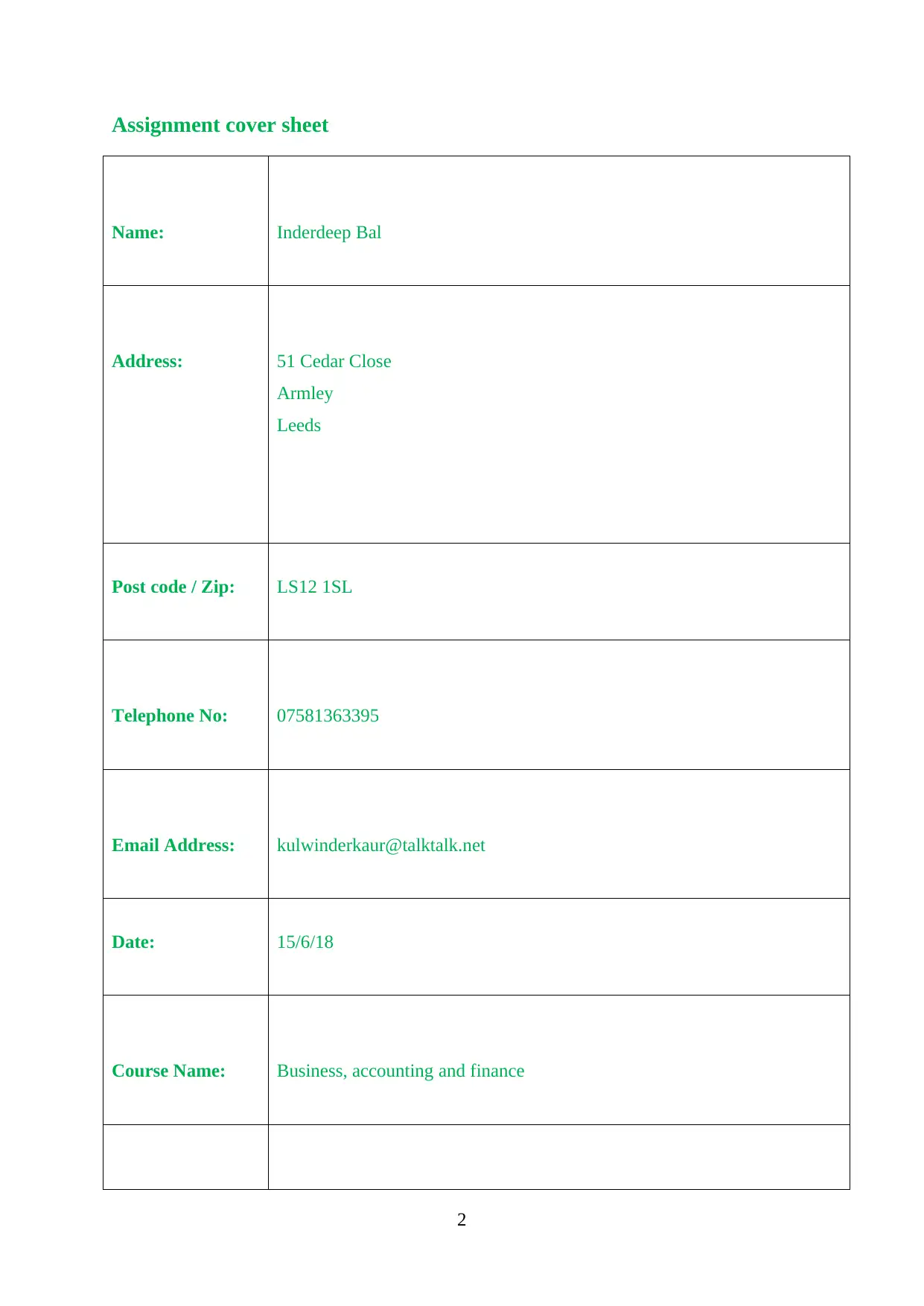
Assignment cover sheet
Name: Inderdeep Bal
Address: 51 Cedar Close
Armley
Leeds
Post code / Zip: LS12 1SL
Telephone No: 07581363395
Email Address: kulwinderkaur@talktalk.net
Date: 15/6/18
Course Name: Business, accounting and finance
2
Name: Inderdeep Bal
Address: 51 Cedar Close
Armley
Leeds
Post code / Zip: LS12 1SL
Telephone No: 07581363395
Email Address: kulwinderkaur@talktalk.net
Date: 15/6/18
Course Name: Business, accounting and finance
2
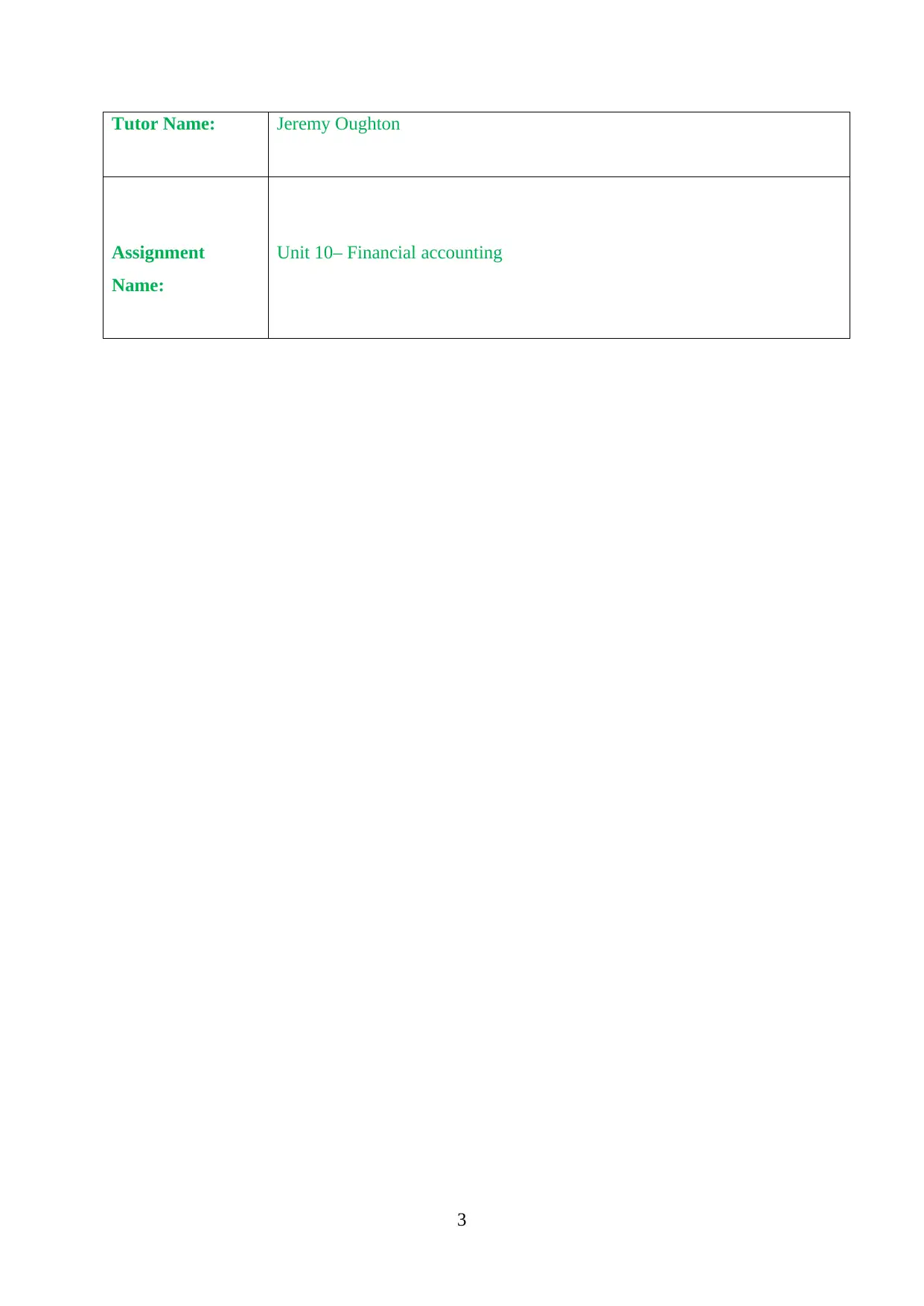
Tutor Name: Jeremy Oughton
Assignment
Name:
Unit 10– Financial accounting
3
Assignment
Name:
Unit 10– Financial accounting
3
⊘ This is a preview!⊘
Do you want full access?
Subscribe today to unlock all pages.

Trusted by 1+ million students worldwide

TABLE OF CONTENT
4
4
Paraphrase This Document
Need a fresh take? Get an instant paraphrase of this document with our AI Paraphraser
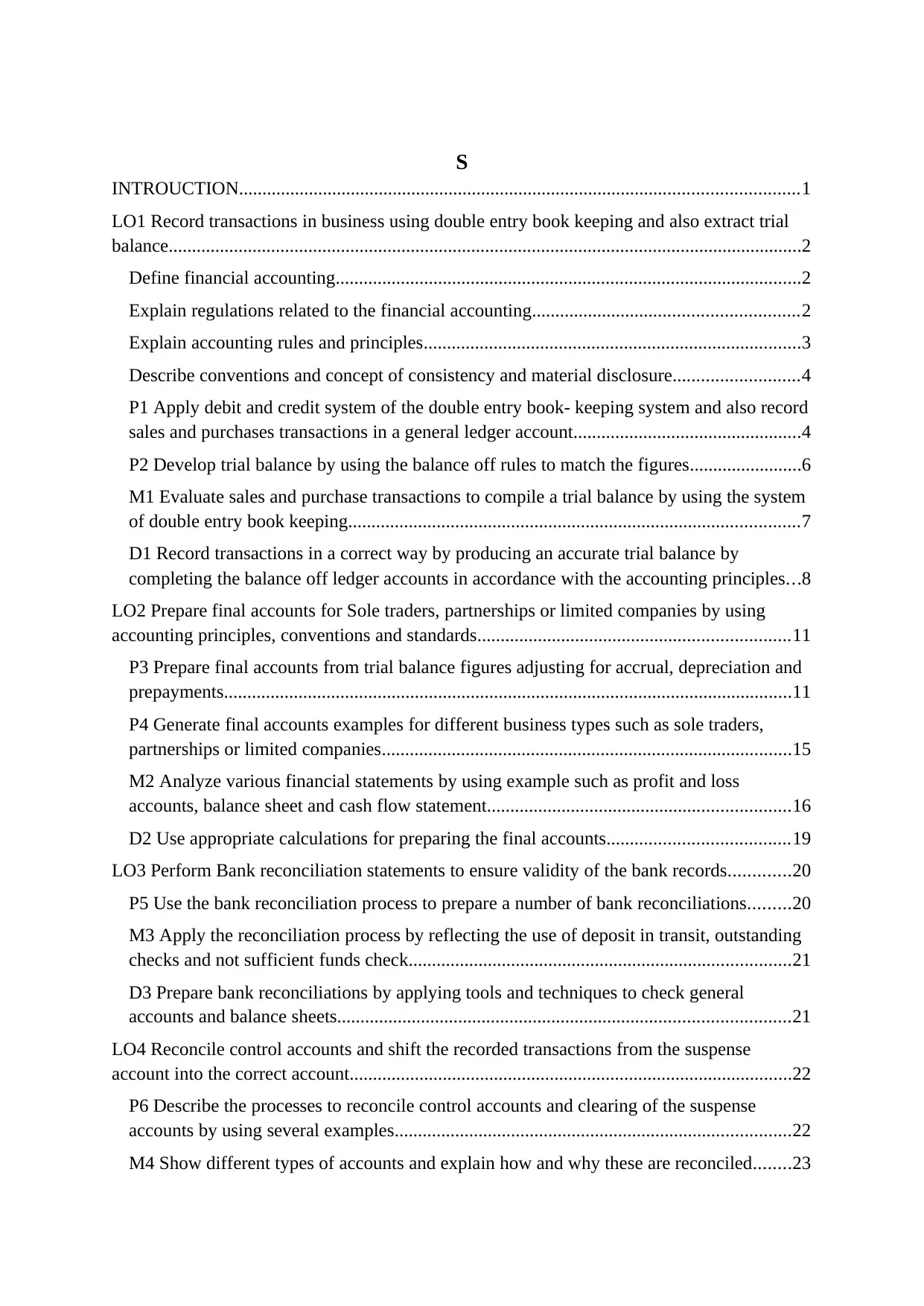
S
INTROUCTION........................................................................................................................1
LO1 Record transactions in business using double entry book keeping and also extract trial
balance........................................................................................................................................2
Define financial accounting....................................................................................................2
Explain regulations related to the financial accounting.........................................................2
Explain accounting rules and principles.................................................................................3
Describe conventions and concept of consistency and material disclosure...........................4
P1 Apply debit and credit system of the double entry book- keeping system and also record
sales and purchases transactions in a general ledger account.................................................4
P2 Develop trial balance by using the balance off rules to match the figures........................6
M1 Evaluate sales and purchase transactions to compile a trial balance by using the system
of double entry book keeping.................................................................................................7
D1 Record transactions in a correct way by producing an accurate trial balance by
completing the balance off ledger accounts in accordance with the accounting principles...8
LO2 Prepare final accounts for Sole traders, partnerships or limited companies by using
accounting principles, conventions and standards...................................................................11
P3 Prepare final accounts from trial balance figures adjusting for accrual, depreciation and
prepayments..........................................................................................................................11
P4 Generate final accounts examples for different business types such as sole traders,
partnerships or limited companies........................................................................................15
M2 Analyze various financial statements by using example such as profit and loss
accounts, balance sheet and cash flow statement.................................................................16
D2 Use appropriate calculations for preparing the final accounts.......................................19
LO3 Perform Bank reconciliation statements to ensure validity of the bank records.............20
P5 Use the bank reconciliation process to prepare a number of bank reconciliations.........20
M3 Apply the reconciliation process by reflecting the use of deposit in transit, outstanding
checks and not sufficient funds check..................................................................................21
D3 Prepare bank reconciliations by applying tools and techniques to check general
accounts and balance sheets.................................................................................................21
LO4 Reconcile control accounts and shift the recorded transactions from the suspense
account into the correct account...............................................................................................22
P6 Describe the processes to reconcile control accounts and clearing of the suspense
accounts by using several examples.....................................................................................22
M4 Show different types of accounts and explain how and why these are reconciled........23
INTROUCTION........................................................................................................................1
LO1 Record transactions in business using double entry book keeping and also extract trial
balance........................................................................................................................................2
Define financial accounting....................................................................................................2
Explain regulations related to the financial accounting.........................................................2
Explain accounting rules and principles.................................................................................3
Describe conventions and concept of consistency and material disclosure...........................4
P1 Apply debit and credit system of the double entry book- keeping system and also record
sales and purchases transactions in a general ledger account.................................................4
P2 Develop trial balance by using the balance off rules to match the figures........................6
M1 Evaluate sales and purchase transactions to compile a trial balance by using the system
of double entry book keeping.................................................................................................7
D1 Record transactions in a correct way by producing an accurate trial balance by
completing the balance off ledger accounts in accordance with the accounting principles...8
LO2 Prepare final accounts for Sole traders, partnerships or limited companies by using
accounting principles, conventions and standards...................................................................11
P3 Prepare final accounts from trial balance figures adjusting for accrual, depreciation and
prepayments..........................................................................................................................11
P4 Generate final accounts examples for different business types such as sole traders,
partnerships or limited companies........................................................................................15
M2 Analyze various financial statements by using example such as profit and loss
accounts, balance sheet and cash flow statement.................................................................16
D2 Use appropriate calculations for preparing the final accounts.......................................19
LO3 Perform Bank reconciliation statements to ensure validity of the bank records.............20
P5 Use the bank reconciliation process to prepare a number of bank reconciliations.........20
M3 Apply the reconciliation process by reflecting the use of deposit in transit, outstanding
checks and not sufficient funds check..................................................................................21
D3 Prepare bank reconciliations by applying tools and techniques to check general
accounts and balance sheets.................................................................................................21
LO4 Reconcile control accounts and shift the recorded transactions from the suspense
account into the correct account...............................................................................................22
P6 Describe the processes to reconcile control accounts and clearing of the suspense
accounts by using several examples.....................................................................................22
M4 Show different types of accounts and explain how and why these are reconciled........23
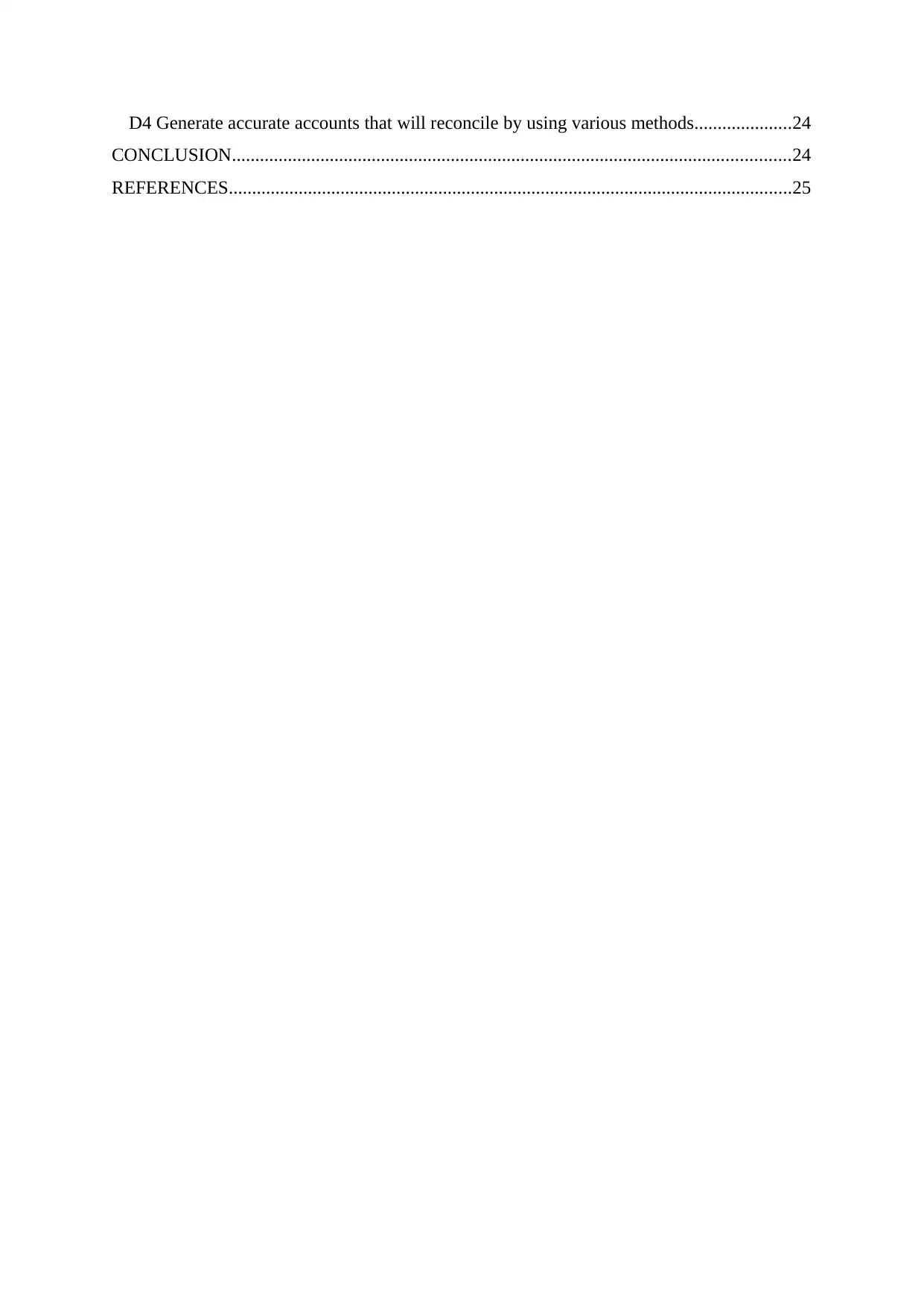
D4 Generate accurate accounts that will reconcile by using various methods.....................24
CONCLUSION........................................................................................................................24
REFERENCES.........................................................................................................................25
CONCLUSION........................................................................................................................24
REFERENCES.........................................................................................................................25
⊘ This is a preview!⊘
Do you want full access?
Subscribe today to unlock all pages.

Trusted by 1+ million students worldwide
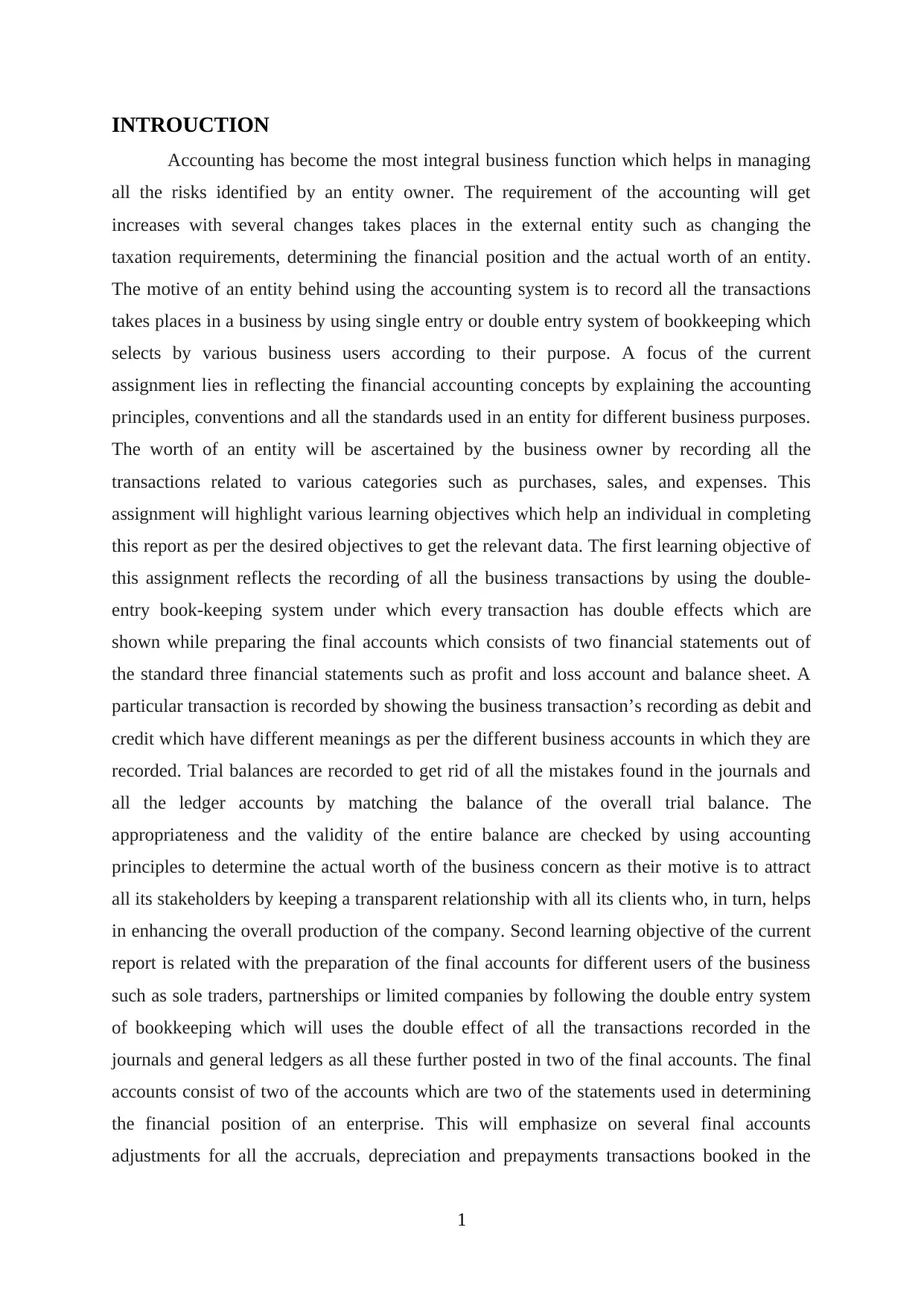
INTROUCTION
Accounting has become the most integral business function which helps in managing
all the risks identified by an entity owner. The requirement of the accounting will get
increases with several changes takes places in the external entity such as changing the
taxation requirements, determining the financial position and the actual worth of an entity.
The motive of an entity behind using the accounting system is to record all the transactions
takes places in a business by using single entry or double entry system of bookkeeping which
selects by various business users according to their purpose. A focus of the current
assignment lies in reflecting the financial accounting concepts by explaining the accounting
principles, conventions and all the standards used in an entity for different business purposes.
The worth of an entity will be ascertained by the business owner by recording all the
transactions related to various categories such as purchases, sales, and expenses. This
assignment will highlight various learning objectives which help an individual in completing
this report as per the desired objectives to get the relevant data. The first learning objective of
this assignment reflects the recording of all the business transactions by using the double-
entry book-keeping system under which every transaction has double effects which are
shown while preparing the final accounts which consists of two financial statements out of
the standard three financial statements such as profit and loss account and balance sheet. A
particular transaction is recorded by showing the business transaction’s recording as debit and
credit which have different meanings as per the different business accounts in which they are
recorded. Trial balances are recorded to get rid of all the mistakes found in the journals and
all the ledger accounts by matching the balance of the overall trial balance. The
appropriateness and the validity of the entire balance are checked by using accounting
principles to determine the actual worth of the business concern as their motive is to attract
all its stakeholders by keeping a transparent relationship with all its clients who, in turn, helps
in enhancing the overall production of the company. Second learning objective of the current
report is related with the preparation of the final accounts for different users of the business
such as sole traders, partnerships or limited companies by following the double entry system
of bookkeeping which will uses the double effect of all the transactions recorded in the
journals and general ledgers as all these further posted in two of the final accounts. The final
accounts consist of two of the accounts which are two of the statements used in determining
the financial position of an enterprise. This will emphasize on several final accounts
adjustments for all the accruals, depreciation and prepayments transactions booked in the
1
Accounting has become the most integral business function which helps in managing
all the risks identified by an entity owner. The requirement of the accounting will get
increases with several changes takes places in the external entity such as changing the
taxation requirements, determining the financial position and the actual worth of an entity.
The motive of an entity behind using the accounting system is to record all the transactions
takes places in a business by using single entry or double entry system of bookkeeping which
selects by various business users according to their purpose. A focus of the current
assignment lies in reflecting the financial accounting concepts by explaining the accounting
principles, conventions and all the standards used in an entity for different business purposes.
The worth of an entity will be ascertained by the business owner by recording all the
transactions related to various categories such as purchases, sales, and expenses. This
assignment will highlight various learning objectives which help an individual in completing
this report as per the desired objectives to get the relevant data. The first learning objective of
this assignment reflects the recording of all the business transactions by using the double-
entry book-keeping system under which every transaction has double effects which are
shown while preparing the final accounts which consists of two financial statements out of
the standard three financial statements such as profit and loss account and balance sheet. A
particular transaction is recorded by showing the business transaction’s recording as debit and
credit which have different meanings as per the different business accounts in which they are
recorded. Trial balances are recorded to get rid of all the mistakes found in the journals and
all the ledger accounts by matching the balance of the overall trial balance. The
appropriateness and the validity of the entire balance are checked by using accounting
principles to determine the actual worth of the business concern as their motive is to attract
all its stakeholders by keeping a transparent relationship with all its clients who, in turn, helps
in enhancing the overall production of the company. Second learning objective of the current
report is related with the preparation of the final accounts for different users of the business
such as sole traders, partnerships or limited companies by following the double entry system
of bookkeeping which will uses the double effect of all the transactions recorded in the
journals and general ledgers as all these further posted in two of the final accounts. The final
accounts consist of two of the accounts which are two of the statements used in determining
the financial position of an enterprise. This will emphasize on several final accounts
adjustments for all the accruals, depreciation and prepayments transactions booked in the
1
Paraphrase This Document
Need a fresh take? Get an instant paraphrase of this document with our AI Paraphraser
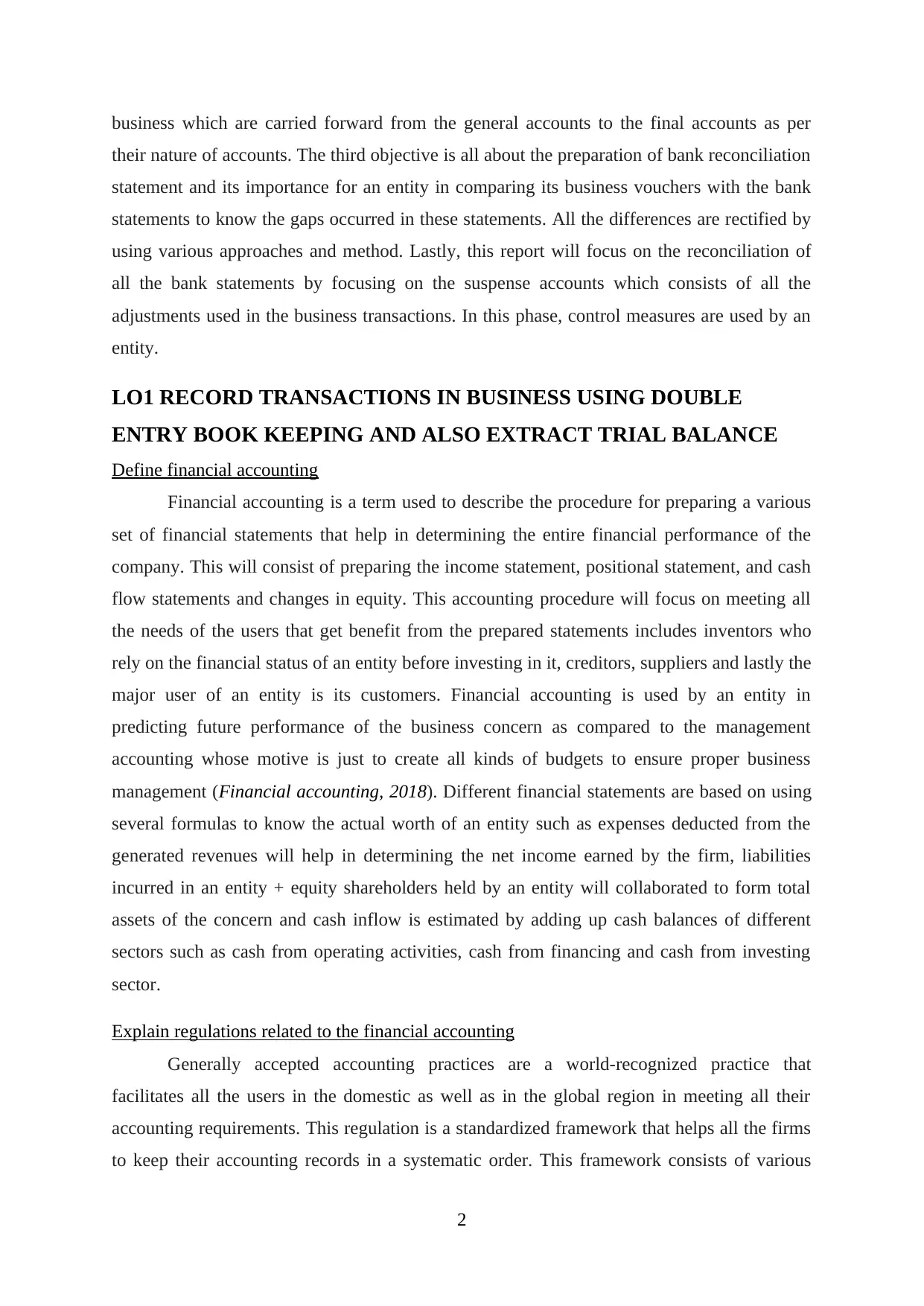
business which are carried forward from the general accounts to the final accounts as per
their nature of accounts. The third objective is all about the preparation of bank reconciliation
statement and its importance for an entity in comparing its business vouchers with the bank
statements to know the gaps occurred in these statements. All the differences are rectified by
using various approaches and method. Lastly, this report will focus on the reconciliation of
all the bank statements by focusing on the suspense accounts which consists of all the
adjustments used in the business transactions. In this phase, control measures are used by an
entity.
LO1 RECORD TRANSACTIONS IN BUSINESS USING DOUBLE
ENTRY BOOK KEEPING AND ALSO EXTRACT TRIAL BALANCE
Define financial accounting
Financial accounting is a term used to describe the procedure for preparing a various
set of financial statements that help in determining the entire financial performance of the
company. This will consist of preparing the income statement, positional statement, and cash
flow statements and changes in equity. This accounting procedure will focus on meeting all
the needs of the users that get benefit from the prepared statements includes inventors who
rely on the financial status of an entity before investing in it, creditors, suppliers and lastly the
major user of an entity is its customers. Financial accounting is used by an entity in
predicting future performance of the business concern as compared to the management
accounting whose motive is just to create all kinds of budgets to ensure proper business
management (Financial accounting, 2018). Different financial statements are based on using
several formulas to know the actual worth of an entity such as expenses deducted from the
generated revenues will help in determining the net income earned by the firm, liabilities
incurred in an entity + equity shareholders held by an entity will collaborated to form total
assets of the concern and cash inflow is estimated by adding up cash balances of different
sectors such as cash from operating activities, cash from financing and cash from investing
sector.
Explain regulations related to the financial accounting
Generally accepted accounting practices are a world-recognized practice that
facilitates all the users in the domestic as well as in the global region in meeting all their
accounting requirements. This regulation is a standardized framework that helps all the firms
to keep their accounting records in a systematic order. This framework consists of various
2
their nature of accounts. The third objective is all about the preparation of bank reconciliation
statement and its importance for an entity in comparing its business vouchers with the bank
statements to know the gaps occurred in these statements. All the differences are rectified by
using various approaches and method. Lastly, this report will focus on the reconciliation of
all the bank statements by focusing on the suspense accounts which consists of all the
adjustments used in the business transactions. In this phase, control measures are used by an
entity.
LO1 RECORD TRANSACTIONS IN BUSINESS USING DOUBLE
ENTRY BOOK KEEPING AND ALSO EXTRACT TRIAL BALANCE
Define financial accounting
Financial accounting is a term used to describe the procedure for preparing a various
set of financial statements that help in determining the entire financial performance of the
company. This will consist of preparing the income statement, positional statement, and cash
flow statements and changes in equity. This accounting procedure will focus on meeting all
the needs of the users that get benefit from the prepared statements includes inventors who
rely on the financial status of an entity before investing in it, creditors, suppliers and lastly the
major user of an entity is its customers. Financial accounting is used by an entity in
predicting future performance of the business concern as compared to the management
accounting whose motive is just to create all kinds of budgets to ensure proper business
management (Financial accounting, 2018). Different financial statements are based on using
several formulas to know the actual worth of an entity such as expenses deducted from the
generated revenues will help in determining the net income earned by the firm, liabilities
incurred in an entity + equity shareholders held by an entity will collaborated to form total
assets of the concern and cash inflow is estimated by adding up cash balances of different
sectors such as cash from operating activities, cash from financing and cash from investing
sector.
Explain regulations related to the financial accounting
Generally accepted accounting practices are a world-recognized practice that
facilitates all the users in the domestic as well as in the global region in meeting all their
accounting requirements. This regulation is a standardized framework that helps all the firms
to keep their accounting records in a systematic order. This framework consists of various
2
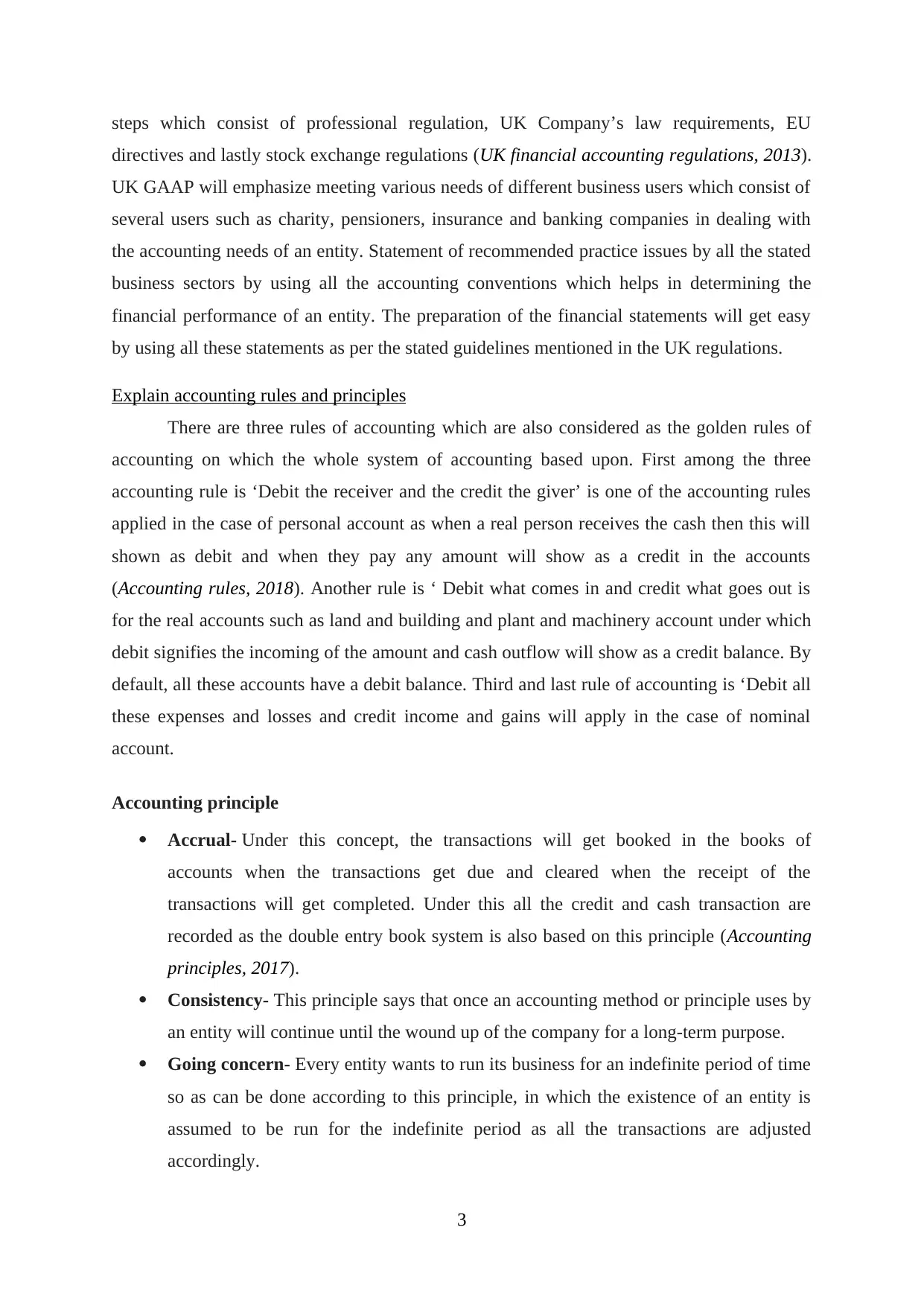
steps which consist of professional regulation, UK Company’s law requirements, EU
directives and lastly stock exchange regulations (UK financial accounting regulations, 2013).
UK GAAP will emphasize meeting various needs of different business users which consist of
several users such as charity, pensioners, insurance and banking companies in dealing with
the accounting needs of an entity. Statement of recommended practice issues by all the stated
business sectors by using all the accounting conventions which helps in determining the
financial performance of an entity. The preparation of the financial statements will get easy
by using all these statements as per the stated guidelines mentioned in the UK regulations.
Explain accounting rules and principles
There are three rules of accounting which are also considered as the golden rules of
accounting on which the whole system of accounting based upon. First among the three
accounting rule is ‘Debit the receiver and the credit the giver’ is one of the accounting rules
applied in the case of personal account as when a real person receives the cash then this will
shown as debit and when they pay any amount will show as a credit in the accounts
(Accounting rules, 2018). Another rule is ‘ Debit what comes in and credit what goes out is
for the real accounts such as land and building and plant and machinery account under which
debit signifies the incoming of the amount and cash outflow will show as a credit balance. By
default, all these accounts have a debit balance. Third and last rule of accounting is ‘Debit all
these expenses and losses and credit income and gains will apply in the case of nominal
account.
Accounting principle
Accrual- Under this concept, the transactions will get booked in the books of
accounts when the transactions get due and cleared when the receipt of the
transactions will get completed. Under this all the credit and cash transaction are
recorded as the double entry book system is also based on this principle (Accounting
principles, 2017).
Consistency- This principle says that once an accounting method or principle uses by
an entity will continue until the wound up of the company for a long-term purpose.
Going concern- Every entity wants to run its business for an indefinite period of time
so as can be done according to this principle, in which the existence of an entity is
assumed to be run for the indefinite period as all the transactions are adjusted
accordingly.
3
directives and lastly stock exchange regulations (UK financial accounting regulations, 2013).
UK GAAP will emphasize meeting various needs of different business users which consist of
several users such as charity, pensioners, insurance and banking companies in dealing with
the accounting needs of an entity. Statement of recommended practice issues by all the stated
business sectors by using all the accounting conventions which helps in determining the
financial performance of an entity. The preparation of the financial statements will get easy
by using all these statements as per the stated guidelines mentioned in the UK regulations.
Explain accounting rules and principles
There are three rules of accounting which are also considered as the golden rules of
accounting on which the whole system of accounting based upon. First among the three
accounting rule is ‘Debit the receiver and the credit the giver’ is one of the accounting rules
applied in the case of personal account as when a real person receives the cash then this will
shown as debit and when they pay any amount will show as a credit in the accounts
(Accounting rules, 2018). Another rule is ‘ Debit what comes in and credit what goes out is
for the real accounts such as land and building and plant and machinery account under which
debit signifies the incoming of the amount and cash outflow will show as a credit balance. By
default, all these accounts have a debit balance. Third and last rule of accounting is ‘Debit all
these expenses and losses and credit income and gains will apply in the case of nominal
account.
Accounting principle
Accrual- Under this concept, the transactions will get booked in the books of
accounts when the transactions get due and cleared when the receipt of the
transactions will get completed. Under this all the credit and cash transaction are
recorded as the double entry book system is also based on this principle (Accounting
principles, 2017).
Consistency- This principle says that once an accounting method or principle uses by
an entity will continue until the wound up of the company for a long-term purpose.
Going concern- Every entity wants to run its business for an indefinite period of time
so as can be done according to this principle, in which the existence of an entity is
assumed to be run for the indefinite period as all the transactions are adjusted
accordingly.
3
⊘ This is a preview!⊘
Do you want full access?
Subscribe today to unlock all pages.

Trusted by 1+ million students worldwide
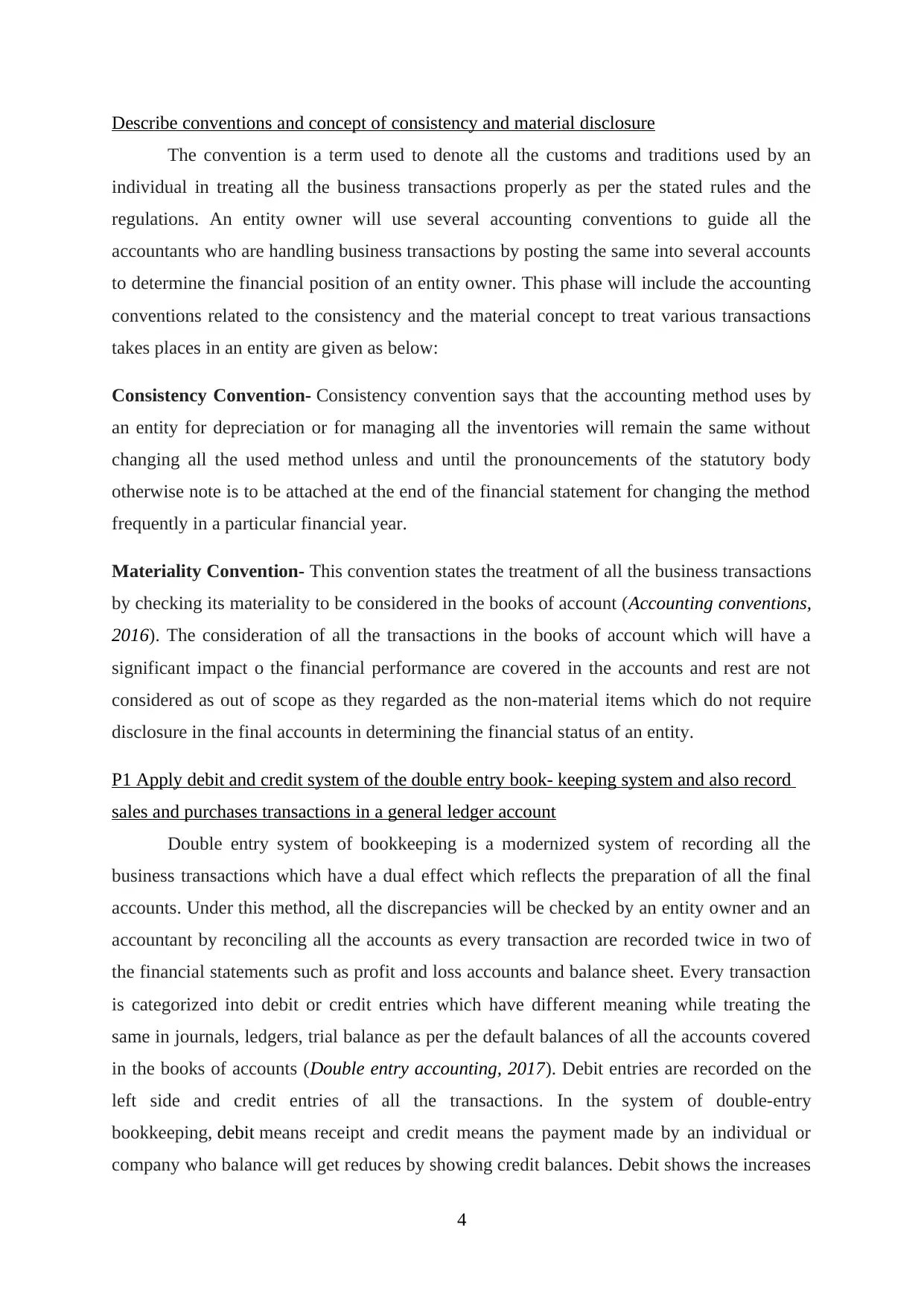
Describe conventions and concept of consistency and material disclosure
The convention is a term used to denote all the customs and traditions used by an
individual in treating all the business transactions properly as per the stated rules and the
regulations. An entity owner will use several accounting conventions to guide all the
accountants who are handling business transactions by posting the same into several accounts
to determine the financial position of an entity owner. This phase will include the accounting
conventions related to the consistency and the material concept to treat various transactions
takes places in an entity are given as below:
Consistency Convention- Consistency convention says that the accounting method uses by
an entity for depreciation or for managing all the inventories will remain the same without
changing all the used method unless and until the pronouncements of the statutory body
otherwise note is to be attached at the end of the financial statement for changing the method
frequently in a particular financial year.
Materiality Convention- This convention states the treatment of all the business transactions
by checking its materiality to be considered in the books of account (Accounting conventions,
2016). The consideration of all the transactions in the books of account which will have a
significant impact o the financial performance are covered in the accounts and rest are not
considered as out of scope as they regarded as the non-material items which do not require
disclosure in the final accounts in determining the financial status of an entity.
P1 Apply debit and credit system of the double entry book- keeping system and also record
sales and purchases transactions in a general ledger account
Double entry system of bookkeeping is a modernized system of recording all the
business transactions which have a dual effect which reflects the preparation of all the final
accounts. Under this method, all the discrepancies will be checked by an entity owner and an
accountant by reconciling all the accounts as every transaction are recorded twice in two of
the financial statements such as profit and loss accounts and balance sheet. Every transaction
is categorized into debit or credit entries which have different meaning while treating the
same in journals, ledgers, trial balance as per the default balances of all the accounts covered
in the books of accounts (Double entry accounting, 2017). Debit entries are recorded on the
left side and credit entries of all the transactions. In the system of double-entry
bookkeeping, debit means receipt and credit means the payment made by an individual or
company who balance will get reduces by showing credit balances. Debit shows the increases
4
The convention is a term used to denote all the customs and traditions used by an
individual in treating all the business transactions properly as per the stated rules and the
regulations. An entity owner will use several accounting conventions to guide all the
accountants who are handling business transactions by posting the same into several accounts
to determine the financial position of an entity owner. This phase will include the accounting
conventions related to the consistency and the material concept to treat various transactions
takes places in an entity are given as below:
Consistency Convention- Consistency convention says that the accounting method uses by
an entity for depreciation or for managing all the inventories will remain the same without
changing all the used method unless and until the pronouncements of the statutory body
otherwise note is to be attached at the end of the financial statement for changing the method
frequently in a particular financial year.
Materiality Convention- This convention states the treatment of all the business transactions
by checking its materiality to be considered in the books of account (Accounting conventions,
2016). The consideration of all the transactions in the books of account which will have a
significant impact o the financial performance are covered in the accounts and rest are not
considered as out of scope as they regarded as the non-material items which do not require
disclosure in the final accounts in determining the financial status of an entity.
P1 Apply debit and credit system of the double entry book- keeping system and also record
sales and purchases transactions in a general ledger account
Double entry system of bookkeeping is a modernized system of recording all the
business transactions which have a dual effect which reflects the preparation of all the final
accounts. Under this method, all the discrepancies will be checked by an entity owner and an
accountant by reconciling all the accounts as every transaction are recorded twice in two of
the financial statements such as profit and loss accounts and balance sheet. Every transaction
is categorized into debit or credit entries which have different meaning while treating the
same in journals, ledgers, trial balance as per the default balances of all the accounts covered
in the books of accounts (Double entry accounting, 2017). Debit entries are recorded on the
left side and credit entries of all the transactions. In the system of double-entry
bookkeeping, debit means receipt and credit means the payment made by an individual or
company who balance will get reduces by showing credit balances. Debit shows the increases
4
Paraphrase This Document
Need a fresh take? Get an instant paraphrase of this document with our AI Paraphraser
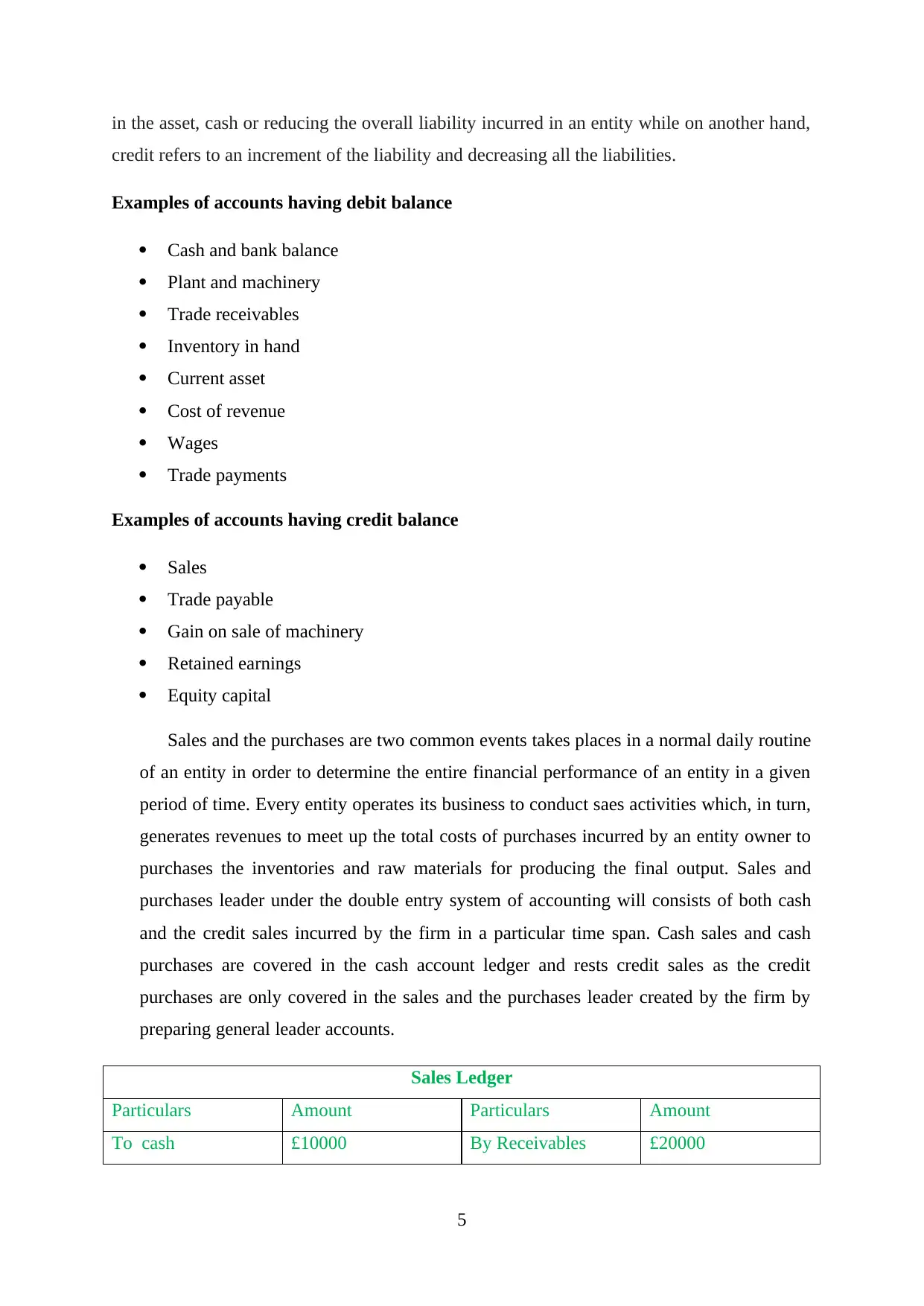
in the asset, cash or reducing the overall liability incurred in an entity while on another hand,
credit refers to an increment of the liability and decreasing all the liabilities.
Examples of accounts having debit balance
Cash and bank balance
Plant and machinery
Trade receivables
Inventory in hand
Current asset
Cost of revenue
Wages
Trade payments
Examples of accounts having credit balance
Sales
Trade payable
Gain on sale of machinery
Retained earnings
Equity capital
Sales and the purchases are two common events takes places in a normal daily routine
of an entity in order to determine the entire financial performance of an entity in a given
period of time. Every entity operates its business to conduct saes activities which, in turn,
generates revenues to meet up the total costs of purchases incurred by an entity owner to
purchases the inventories and raw materials for producing the final output. Sales and
purchases leader under the double entry system of accounting will consists of both cash
and the credit sales incurred by the firm in a particular time span. Cash sales and cash
purchases are covered in the cash account ledger and rests credit sales as the credit
purchases are only covered in the sales and the purchases leader created by the firm by
preparing general leader accounts.
Sales Ledger
Particulars Amount Particulars Amount
To cash £10000 By Receivables £20000
5
credit refers to an increment of the liability and decreasing all the liabilities.
Examples of accounts having debit balance
Cash and bank balance
Plant and machinery
Trade receivables
Inventory in hand
Current asset
Cost of revenue
Wages
Trade payments
Examples of accounts having credit balance
Sales
Trade payable
Gain on sale of machinery
Retained earnings
Equity capital
Sales and the purchases are two common events takes places in a normal daily routine
of an entity in order to determine the entire financial performance of an entity in a given
period of time. Every entity operates its business to conduct saes activities which, in turn,
generates revenues to meet up the total costs of purchases incurred by an entity owner to
purchases the inventories and raw materials for producing the final output. Sales and
purchases leader under the double entry system of accounting will consists of both cash
and the credit sales incurred by the firm in a particular time span. Cash sales and cash
purchases are covered in the cash account ledger and rests credit sales as the credit
purchases are only covered in the sales and the purchases leader created by the firm by
preparing general leader accounts.
Sales Ledger
Particulars Amount Particulars Amount
To cash £10000 By Receivables £20000
5
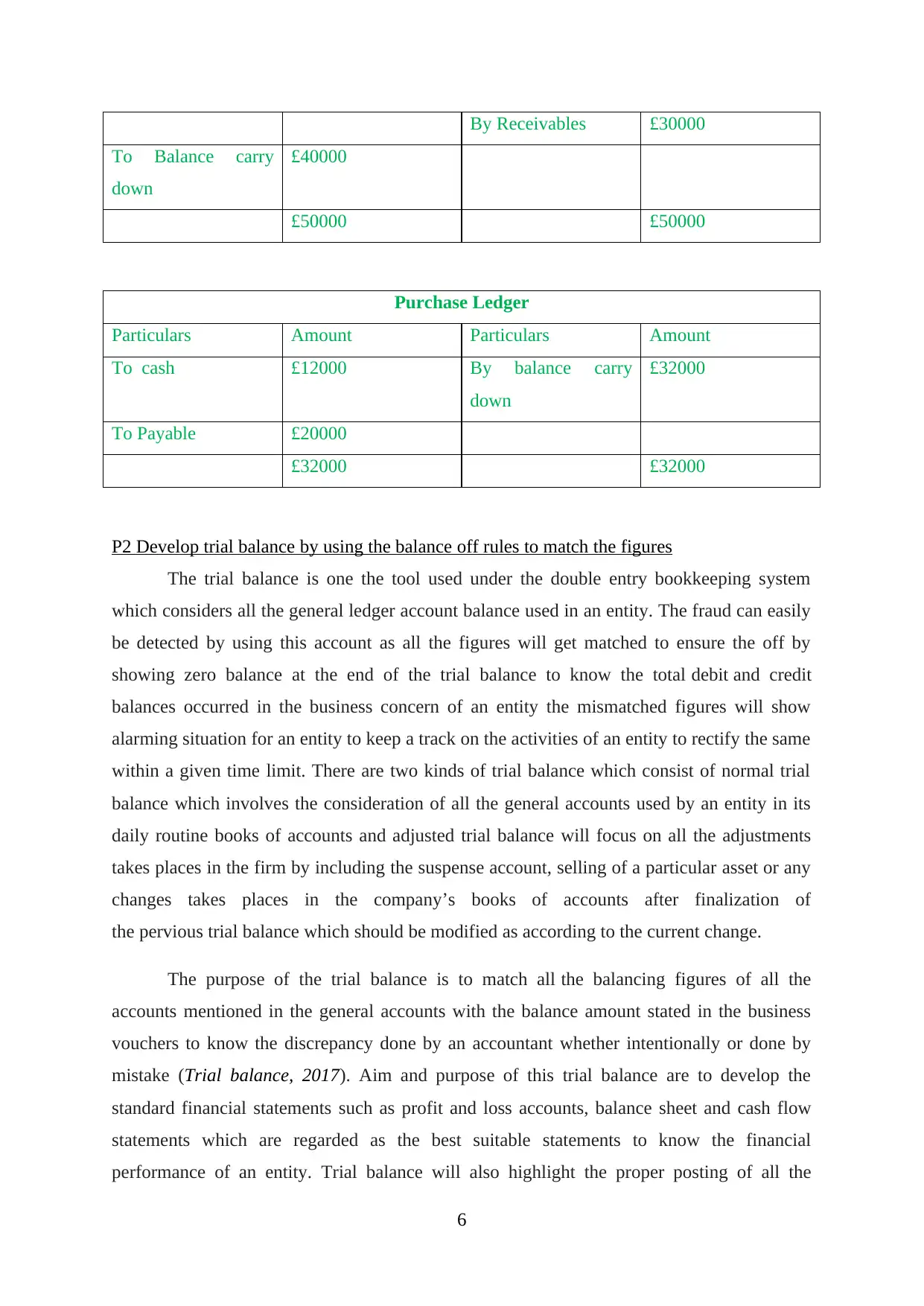
By Receivables £30000
To Balance carry
down
£40000
£50000 £50000
Purchase Ledger
Particulars Amount Particulars Amount
To cash £12000 By balance carry
down
£32000
To Payable £20000
£32000 £32000
P2 Develop trial balance by using the balance off rules to match the figures
The trial balance is one the tool used under the double entry bookkeeping system
which considers all the general ledger account balance used in an entity. The fraud can easily
be detected by using this account as all the figures will get matched to ensure the off by
showing zero balance at the end of the trial balance to know the total debit and credit
balances occurred in the business concern of an entity the mismatched figures will show
alarming situation for an entity to keep a track on the activities of an entity to rectify the same
within a given time limit. There are two kinds of trial balance which consist of normal trial
balance which involves the consideration of all the general accounts used by an entity in its
daily routine books of accounts and adjusted trial balance will focus on all the adjustments
takes places in the firm by including the suspense account, selling of a particular asset or any
changes takes places in the company’s books of accounts after finalization of
the pervious trial balance which should be modified as according to the current change.
The purpose of the trial balance is to match all the balancing figures of all the
accounts mentioned in the general accounts with the balance amount stated in the business
vouchers to know the discrepancy done by an accountant whether intentionally or done by
mistake (Trial balance, 2017). Aim and purpose of this trial balance are to develop the
standard financial statements such as profit and loss accounts, balance sheet and cash flow
statements which are regarded as the best suitable statements to know the financial
performance of an entity. Trial balance will also highlight the proper posting of all the
6
To Balance carry
down
£40000
£50000 £50000
Purchase Ledger
Particulars Amount Particulars Amount
To cash £12000 By balance carry
down
£32000
To Payable £20000
£32000 £32000
P2 Develop trial balance by using the balance off rules to match the figures
The trial balance is one the tool used under the double entry bookkeeping system
which considers all the general ledger account balance used in an entity. The fraud can easily
be detected by using this account as all the figures will get matched to ensure the off by
showing zero balance at the end of the trial balance to know the total debit and credit
balances occurred in the business concern of an entity the mismatched figures will show
alarming situation for an entity to keep a track on the activities of an entity to rectify the same
within a given time limit. There are two kinds of trial balance which consist of normal trial
balance which involves the consideration of all the general accounts used by an entity in its
daily routine books of accounts and adjusted trial balance will focus on all the adjustments
takes places in the firm by including the suspense account, selling of a particular asset or any
changes takes places in the company’s books of accounts after finalization of
the pervious trial balance which should be modified as according to the current change.
The purpose of the trial balance is to match all the balancing figures of all the
accounts mentioned in the general accounts with the balance amount stated in the business
vouchers to know the discrepancy done by an accountant whether intentionally or done by
mistake (Trial balance, 2017). Aim and purpose of this trial balance are to develop the
standard financial statements such as profit and loss accounts, balance sheet and cash flow
statements which are regarded as the best suitable statements to know the financial
performance of an entity. Trial balance will also highlight the proper posting of all the
6
⊘ This is a preview!⊘
Do you want full access?
Subscribe today to unlock all pages.

Trusted by 1+ million students worldwide
1 out of 33
Related Documents
Your All-in-One AI-Powered Toolkit for Academic Success.
+13062052269
info@desklib.com
Available 24*7 on WhatsApp / Email
![[object Object]](/_next/static/media/star-bottom.7253800d.svg)
Unlock your academic potential
Copyright © 2020–2025 A2Z Services. All Rights Reserved. Developed and managed by ZUCOL.





